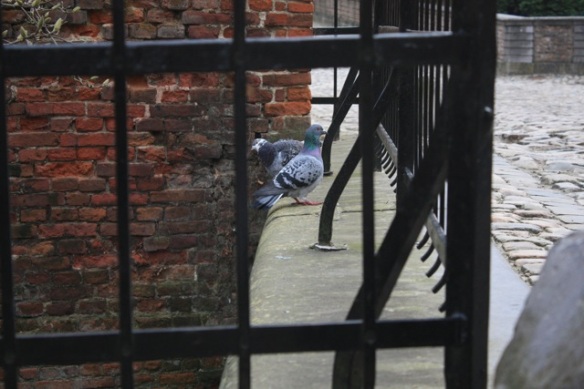Thursday, 7 March 2013. After yesterday, today to the Groot Begijnhof in Leuven, Belgium.
The Groot Begijnhof (Grand Béguinage in French) is a well-preserved and completely restored historical quarter of a dozen streets in the city center of Leuven.
Two branches of the Dijle river cross it, bridged by three bridges.
Near a lawn, great tit and blackbird.
The Jesuit order played a role in Leuven history. So, in the Groot Begijnhof, there is this small statue of Ignatius of Loyola, the founder of that order.
Back at a Dijle bridge, domestic pigeons. Also, Egyptian geese flying overhead.
Then, after the Groot Begijnhof, on to the M-Museum Leuven.
This video says about itself:
A small fragment of a musical performance in the M-Museum, in Leuven, Belgium.
This museum has a big art collection, from the Middle Ages to the nineteenth century. But they don’t exhibit all of that permanently; like many other museums.
When you enter, you see religious sculptures. One from the twelfth century, one from the fourteenth century. Most are from the sixteenth century, a “golden age” for the Low Countries, especially the southern provinces. However, the museum does not show much from the seventeenth and eighteenth centuries. Then, the Habsburg rulers had managed to oppress the sixteenth century revolt against King Philip II of Spain: not in the north, which went on to have its Golden Age in the seventeenth century and would become the Netherlands; in the south, which later became Belgium. Though early in the seventeenth century, Rubens and others still made Antwerp a center of art, Leuven and many other southern Low Countries areas became backwaters economically and artistically under the Spanish and Austrian Habsburg monarchs.
The museum does have a lot of nineteenth century objects. Many of them are by Constantin Meunier (12 April 1831 – 4 April 1905). Though born in a Brussels working class neighbourhood, Meunier worked in Leuven at his painting and sculpture for quite some time.
A major theme in Meunier’s work is the Belgian working class, their exploitation and their bad situation at work. His style is called “social realism”.

Constantin Meunier made this sculpture after a fire in a coal mine in 1887. It killed 120 miners. The sculpture depicts a mother, recognizing the dead body of her son among the victims of the disaster.








Just beautiful:)
LikeLike
Thank you!
LikeLike
Utterly beautiful… the red bricks, the winding water, the bare trees, and the heartbreaking sculpture of mother and son… and the exquisite violin… a great treat…
LikeLike
Thank you so much, Valerie! I hope to have more blog posts like this.
LikeLike
Pingback: Leuven in Belgium, botanical garden again | Dear Kitty. Some blog
Pingback: Judith Leyster and other seventeenth century Low Countries women painters | Dear Kitty. Some blog
Pingback: Militarist propaganda in Germany | Dear Kitty. Some blog
This video is about beavers in the Dijle river near the Groot Begijnhof in Leuven.
LikeLike
Pingback: Opposition in Germany against World War I | Dear Kitty. Some blog
Pingback: German militarism reviving | Dear Kitty. Some blog
Pingback: Singer museum in Laren, the Netherlands | Dear Kitty. Some blog
Pingback: German intellectuals’ World War I collaboration with militarism | Dear Kitty. Some blog
Pingback: Brazil, inequalty and elections, by Leonardo Boff | Dear Kitty. Some blog
Pingback: Pennsylvanian bishop neglected Belgian child abuse alarm | Dear Kitty. Some blog